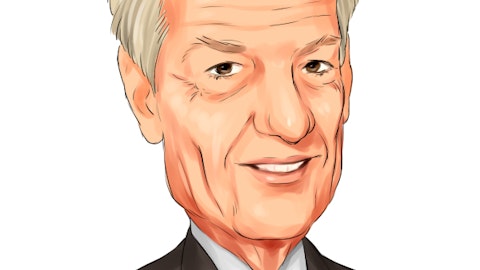Steel City Capital LP, an investment management firm, published its first quarter 2021 investor letter – a copy of which can be downloaded here. A net return of 7.6% was delivered by the fund for the Q1 of 2021, above the S&P 500 and MSCI All World Index that delivered a 5.8% and 4.8% returns respectively, but below its Russell 2000 benchmark, that had a 12.9% gain for the same period. You can view the fund’s top 5 holdings to have a peek at their top bets for 2021.
Steel City Capital, in their Q1 2021 investor letter, mentioned Carvana Co. (NYSE: CVNA), and shared their insights on the company. Carvana Co. is a Tempe, Arizona-based used car dealers company that currently has a $49.1 billion market capitalization. Since the beginning of the year, CVNA delivered a 19.09% return, impressively extending its 12-month gains to 275.34%. As of April 30, 2021, the stock closed at $285.26 per share.
Here is what Steel City Capital has to say about Carvana Co. in their Q1 2021 investor letter:
“Carvana’s (CVNA) 4Q’20 results weren’t particularly great. EBITDA was negative ($70) million, a stark turnaround on a sequential basis from a first-ever EBITDA profit of $21 million in 3Q’20. The culprit was a steep drop off in retail unit GPU ($1,265 vs. $1,857) and wholesale unit GPU ($358 vs. $1,113) as some of the COVID-driven aberrations in the used car market began to abate.
The company’s presentation of EBITDA (calculated “bottom up”) is dubious, as it commingles non-operating items including mark-to-market changes in its retained securitization portfolio. With the exception of 1Q’20, when ABS markets were going haywire, this line item provided a tailwind throughout 2020, including a gain of $5 million in 4Q’20. Also on the non-operating self-help front, management released a reserve for vehicle service contract cancellations in 4Q’20, adding another $7 million to EBITDA, and boosting “Other” GPU by $96.
Putting it all together, I put operating EBITDA closer to negative ($82) million vs. the $70 million printed by the company. This is a larger loss than 4Q’19 (calculated on a similar operating basis) despite the company selling 43% more retail units y/y!
Management didn’t provide formal guidance for 2021, but did offer guardrails for how to think about the year. Retail unit growth is expected to accelerate from last year’s 37%, with total revenue tracking in-line with retail unit growth. Total revenue per retail unit was $22,885 last year, meaning the company thinks it can hold this metric relatively flat throughout the year. Management also noted it expects some softening in retail ASPs throughout the year (“I think the gains that we saw in ASP in the back half of the year, we expect to moderate a little bit in 20216 “), with the implication being “Other” revenue – including financing – will serve as an offset.
Why look at total revenue per retail unit? The company guides to total GPU, which itself is an apples-and-oranges mix of total gross profit divided by only retail units. As for total GPU, management called out expectations for “mid- $3,000s” in FY21. Putting the pieces together, $3,500 of total GPU divided by $22,885 of total revenue per retail unit implies gross margin of 15.3% for the year, roughly 100 bps of pickup vs. last year’s 14.2%.
On the EBITDA front, management guided to continuing cost leverage but still a “small EBITDA margin loss” in FY’21. Splitting the difference between last year’s negative 4.6% EBITDA margin and breakeven gives us something in the realm of a 2.5% EBITDA margin loss for FY’21. So, 200 bps of total improvement, 100 bps of which we know is coming from GPU margin. The other 100 bps, therefore, must come from SG&A.
Applying a negative 2.5% margin to $22,885 of total revenue per retail unit implies about $575 of negative EBITDA per unit sold. This also allows us to back into implied cash SG&A per unit of $4,075, which is 17.8%, and 100 bps better than last year’s 18.8%.
The unknown variable is what retail unit growth actually looks like in 2021. All we know is it’s going to “accelerate” vs. last year’s 37%. Doing some back of the envelope sensitivity implies negative EBITDA ranging from a ($210) million loss at 50% unit growth to a ($250) million loss at 80% growth (A classic case of “We lose money on every sale but make up for it in volume!”). For context, the street is currently forecasting a negative EBITDA margin of 1.0% and negative EBITDA of ($87.5) million.
I think one of the big risks to the company’s outlook isn’t necessarily on the volume front – I believe management when they say they can’t keep pace with demand – but instead on the GPU front. Before 2H’20, only once in the prior 14 quarters did total GPU exceed $3,000. 3Q’20 reached an all-time high due to strong vehicle pricing and strong finance gross profit, while 4Q’20 got its boost from finance gross profit and the abovementioned reserve release. Finance GPU is a function of both absolute interest rates and ABS spreads, and the trajectory of absolute rates since the beginning of 2021 calls into question the company’s ability to maintain finance GPU at $1,400, let alone grow it.”

Our calculations show that Carvana Co. (NYSE: CVNA) does not belong in our list of the 30 Most Popular Stocks Among Hedge Funds. As of the end of the fourth quarter of 2020, Carvana Co. was in 63 hedge fund portfolios, compared to 53 funds in the third quarter. CVNA delivered a 9.22% return in the past 3 months.
The top 10 stocks among hedge funds returned 231.2% between 2015 and 2020, and outperformed the S&P 500 Index ETFs by more than 126 percentage points. We know it sounds unbelievable. You have been dismissing our articles about top hedge fund stocks mostly because you were fed biased information by other media outlets about hedge funds’ poor performance. You could have doubled the size of your nest egg by investing in the top hedge fund stocks instead of dumb S&P 500 ETFs. Here you can watch our video about the top 5 hedge fund stocks right now. All of these stocks had positive returns in 2020.
At Insider Monkey, we scour multiple sources to uncover the next great investment idea. For example, Federal Reserve has been creating trillions of dollars electronically to keep the interest rates near zero. We believe this will lead to inflation and boost real estate prices. So, we recommended this real estate stock to our monthly premium newsletter subscribers. We go through lists like the 15 best innovative stocks to buy to pick the next Tesla that will deliver a 10x return. Even though we recommend positions in only a tiny fraction of the companies we analyze, we check out as many stocks as we can. We read hedge fund investor letters and listen to stock pitches at hedge fund conferences. You can subscribe to our free daily newsletter on our website:
Disclosure: None. This article is originally published at Insider Monkey.




